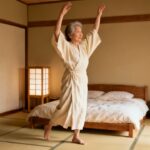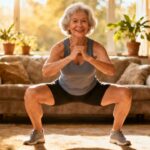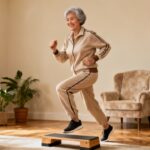Have you ever finished a walk—doing what you’ve always been told is the best exercise—and still felt like your legs were dragging behind you?
That heaviness, that ache, as if your body is working harder than it should just to stay upright. You’re not alone. And more importantly, it’s not your fault.
For years, we believed walking alone was the ultimate key to healthy aging. But there’s a hidden truth most doctors and trainers rarely mention. There’s a muscle deep in your lower leg that scientists are now calling your body’s second heart.
If this muscle is asleep, as it often is especially after 60, walking, standing, even balancing becomes harder than it needs to be. Your energy drains, swelling builds, stability fades.
But here’s the good news: this powerful internal engine isn’t gone. It’s just waiting to be reactivated.
The Second Heart: Your Body’s Hidden Power Source
Buried inside your lower legs lies a hidden engine most people never think about: a powerful muscle called the soleus. It doesn’t look like much on the surface, but its role in your body is nothing short of heroic.
In fact, scientists and cardiologists are now calling the soleus your second heart. Why? Because every time it contracts, it pumps blood back up from your legs to your heart, fighting gravity, reducing swelling, and boosting circulation.
After age 60, when circulation tends to slow and muscles naturally weaken, this pump is often left inactive. Walking alone only gives this muscle a light tap on the shoulder.
But today, we’re going to give it a proper wakeup call right from the safety and comfort of your chair.
Exercise 1: Seated Heel Raises—Wake Up the Second Heart
If you’ve ever felt your legs swell by afternoon or noticed how hard it can be just to get up from your chair without a wobble, this first movement might just be your turning point.
How to Do It—Only Takes 2 Minutes
- Sit tall in a sturdy chair, feet flat on the floor, knees at a 90° angle
- Place your palms gently on top of your knees or use two small water bottles for light pressure
- Keep the balls of your feet pressed to the floor
- Slowly lift both heels as high as you comfortably can
- Pause and hold at the top for 1–2 seconds
- Then slowly lower your heels back to the floor with control
- Repeat 10 to 15 times once or twice a day
This small controlled movement activates the soleus and trains it to do what it was built for: pumping blood, supporting balance, and energizing your entire lower body.
Exercise 2: Standing Calf Raise—From Gravity to Power
There’s a quiet moment that happens in everyday life—one that tells you more about your body than any blood test ever could. It’s the second you stand up and feel just a little unsure on your feet.
Maybe it’s a subtle sway, a hesitation before taking your first step. This movement is where you reclaim stability from the ground up.
How to Do It
- Stand facing a sturdy surface like a kitchen countertop or heavy chair
- Place both hands lightly on the surface—just enough to feel supported, not to lean
- Keep feet hip-width apart, toes pointing forward
- Shift your weight slightly toward the balls of your feet
- Slowly lift both heels as high as you comfortably can
- Pause at the top and feel your calf muscles activate
- Slowly lower your heels back to the ground with control
- Repeat 10–15 times
This movement activates both the soleus and the gastrocnemius, the outer and inner engines of your lower leg. But even more powerful is what happens neurologically.
Each rise and descent trains the nerves around your ankles, knees, and hips to sense your body’s position in space, a process called proprioception.
Exercise 3: Bent Knee Calf Raise, Single Leg—Unlock the Deep Engine
There’s a moment most people never notice—the moment your body decides whether it will stay standing or start falling.
It doesn’t happen when you take a big step. It happens in the tiny micro-movements: shifting your weight, standing on one foot to put on a sock, stepping onto a curb.
How to Do It—Slow, Strong, and Intentional
- Stand behind a sturdy chair or countertop and lightly hold for balance
- Shift your weight onto your right leg and lift your left foot just an inch off the floor
- Slightly bend your right knee—not a squat, just a soft athletic bend
- From this position, slowly lift your right heel as high as you comfortably can
- Pause at the top and feel the activation deep in your lower leg
- Slowly lower your heel back down to the floor with full control
- Repeat 8–12 reps on the right leg, then switch sides
When your knee is straight, your body naturally uses the gastrocnemius, the flashy outer calf muscle. But when you bend the knee, you take that muscle out of the equation. That forces your soleus, the deep endurance muscle, to activate.
Why This Matters More Than Walking
Most people over 60 have a dormant soleus. It’s not weak—it’s just forgotten. These movements remind your nervous system that it’s still there, still powerful, and still capable of holding you steady in the moments that matter most.
Unlike walking, which uses these muscles only partially, these targeted movements put them through their full range, which builds resilient, long-lasting strength, pumps stagnant blood and lymph from your feet, sends energy back toward your heart, and trains your ankles to control your body weight with grace, not guesswork.
Safety Considerations
These movements are very gentle, but if you have a recent blood clot (DVT), severe varicose veins with pain, any sharp or sudden calf pain, recent foot or ankle surgery, experience dizziness when standing, have severe balance issues, or are at risk of falling without support, please consult your doctor before starting.
Conclusion: Reclaim Your Foundation
What you’ve learned today goes far beyond just three exercises. You’ve reawakened a part of your body that most people don’t even know exists—a powerful inner muscle that pumps blood, supports posture, and quietly protects your balance every single day. That’s not fitness. That’s freedom.
At this stage of life, it’s easy to believe that decline is inevitable—that wobbly legs, heavy steps, and swelling are just part of the deal.
But what you’ve proven today is that small intentional action can change the trajectory. You didn’t need a gym. You didn’t need fancy equipment. All you needed was your breath, your focus, and a willingness to move.
These three movements—seated, standing, and deep activation—form a foundation, a personal ritual, a way of saying, “I still have control. I still have strength. I still choose to support myself from the ground up.” And that’s something no medication or device can give you. Only you can.








